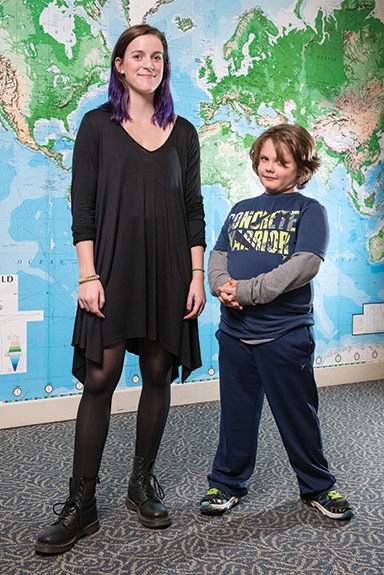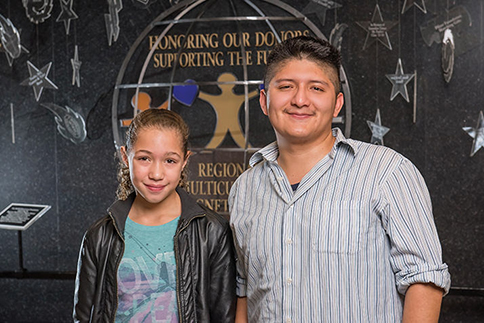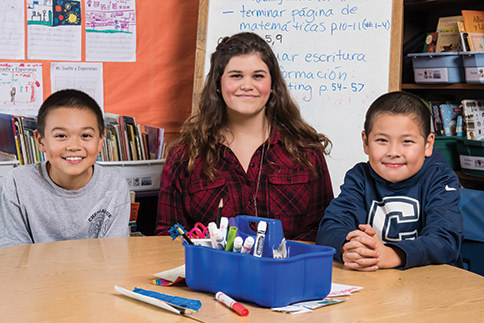Coded in Language
An innovative language acquisition class sets Conn students loose on a New London magnet school.
Sterling Gillette wants to be a scientist when he grows up.
The 8-year old, who already understands the survival skills of bacteria, curiously wonders about the comet that killed the dinosaurs.
“I want to see what really caused that comet to hit the planet we live on, because you’d think it would have wiped out everything, but something had to survive,” he ponders.
“Like bacteria.”
Sterling has a tuft of messy hair and a mischievous smile. He appears to be a typical third grader. However, he attends the Regional Multicultural Magnet School in New London, and when he tells you his favorite color is red, he proudly speaks it in Russian.
Sterling takes Russian in the world languages program, a six-week, after-school program that the RMMS runs in conjunction with Connecticut College. Sterling is one of 70 elementary students learning languages such as Russian, Arabic, Chinese, Spanish and French. The rub is that 18 Connecticut College students team-teach the 45-minute classes.
For five of these students, the RMMS program makes up the practicum portion of their language acquisition course, taught by Petko Ivanov, lecturer in Slavic studies. In his course, students learn the theories behind how one acquires a second language, and then they test these theories at the magnet school.

Kaitlin Cunningham ’16 is in Ivanov’s class. She began studying Russian at Conn because of her interest in Russian history. After her study-away program in Moscow, she’s now considered “advanced,” with only “superior” to go before her mastery of Russian is at the “native” level.
“The reason I took [Ivanov’s] class was for this teaching aspect,” Cunningham says. “But it’s a super interesting classroom experience as well, learning how we learn second languages. It’s a mentally stimulating experience.”
Cunningham is “really into” learning languages. It’s an entry point through which one can better understand a different culture, a people, especially during the era of globalization.
“I don’t think you can really understand other people or other cultures unless you speak their language or know a little bit about their language. A lot of culture is coded in a language,” she argues.
“It’s exciting that kids aren’t just going to keep speaking English as the world globalizes and English becomes a global language. Kids still want to learn other languages and use them when they become adults.”
Sterling, who’s wearing a blue shirt with neon-green letters spelling out “Concrete Warrior,” isn’t thinking about globalization. To him, Cunningham is known as “Mrs. Kaitlin,” one of his favorite teachers. A few weeks into the class he already has an easy rapport with Mrs. Kaitlin. When she speaks Russian to him, asking him to say his name, he takes a moment to collect his thoughts, and responds in Russian.
Then they slap hands. And Sterling smiles, proudly.
“You can see how children are like sponges. You say something once and they’ll pick up on it,” Cunningham says.
Social justice
The world is, as Cunningham says, becoming more globalized; English is becoming the language of the world, so why should grade-school kids bother learning another language?
“Every different language is a window to another world,” Ivanov says.
With his gray beard and disheveled appearance, Ivanov looks like a member of the intelligentsia. By all accounts, the Bulgarian-born professor is a language rock star, having taught Russian at the Defense Language Institute in Monterey, California—the place where those in the Department of Defense and intelligence services (spies) immerse themselves in the languages of hotspots around the globe.
Ivanov jokes, “Russian is a disease. Once you got it, it stays with you for life.” By that he means learning another language becomes part of your identity.
“My role is to diagnose this disease,” he says. “Just being exposed to another language is a cultural experience. It’s multiculturalism in action. Being exposed to differences.”


